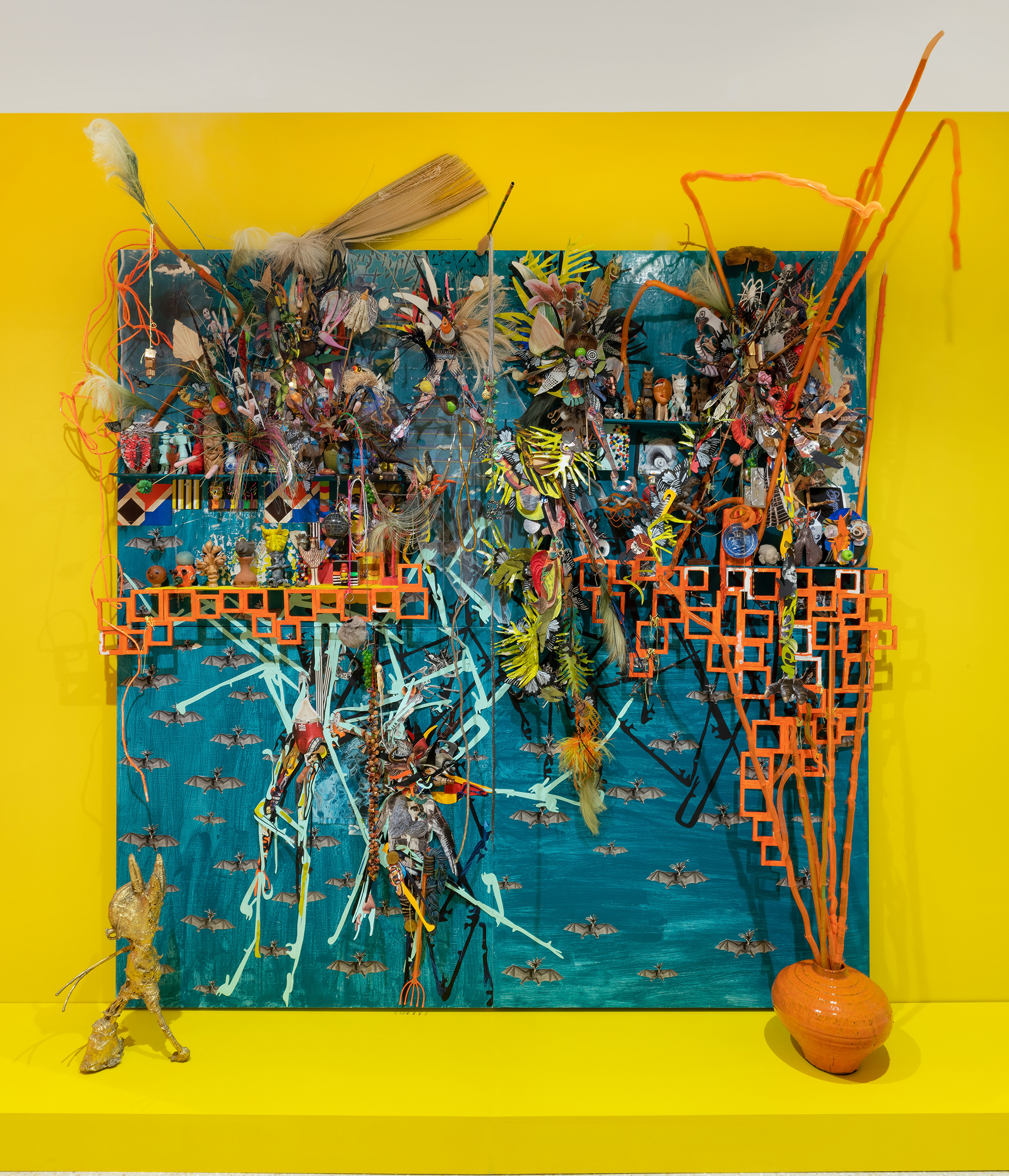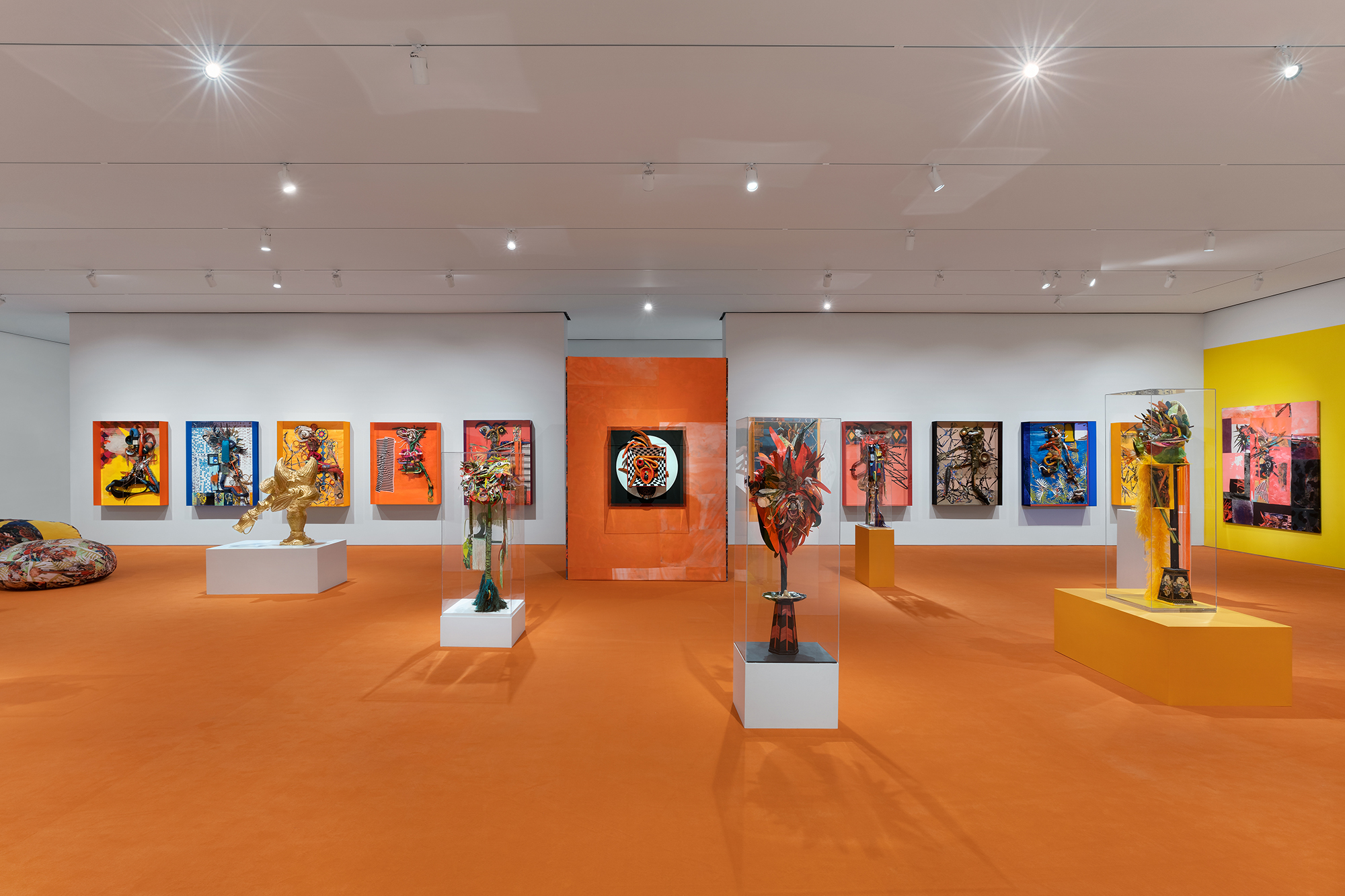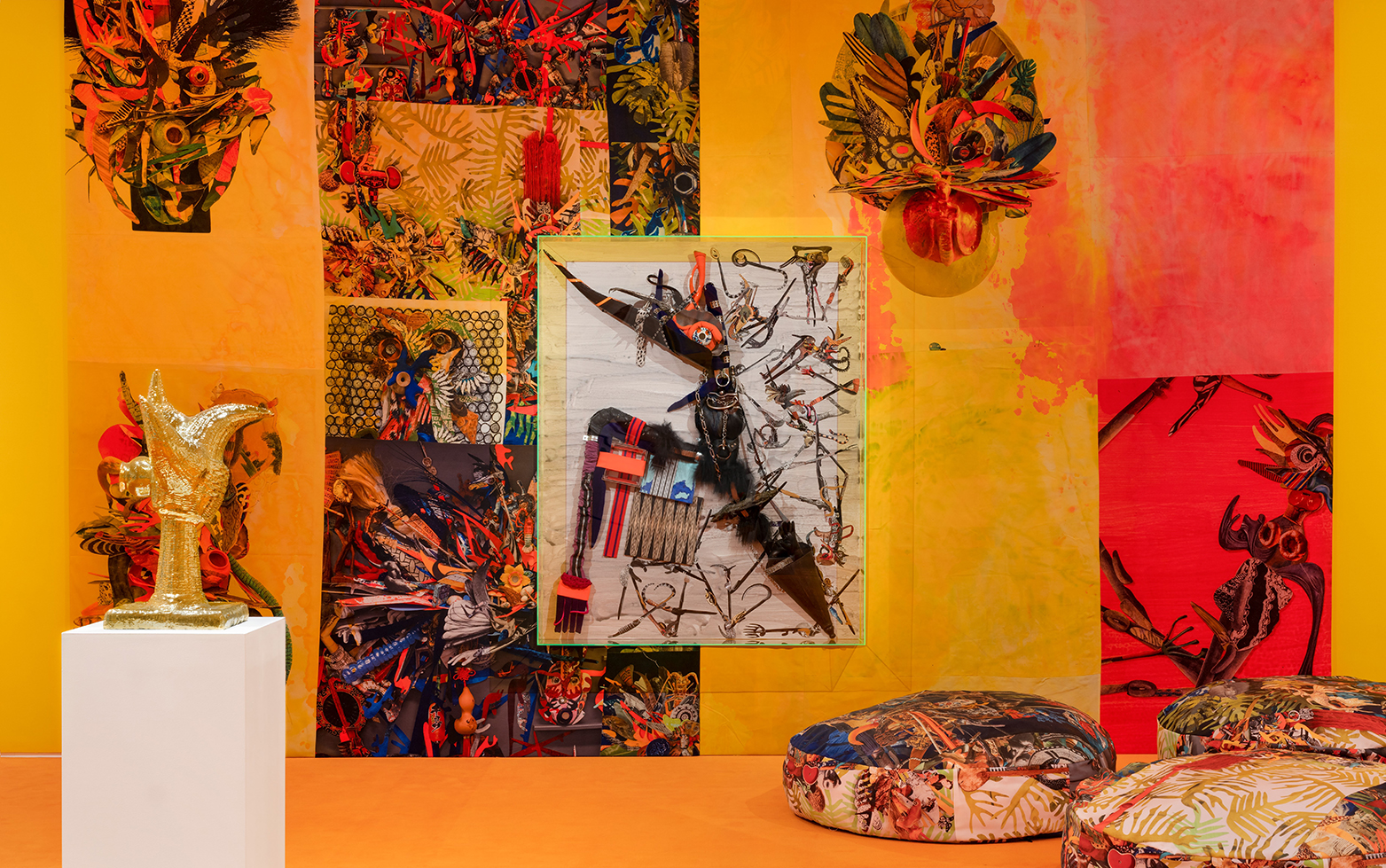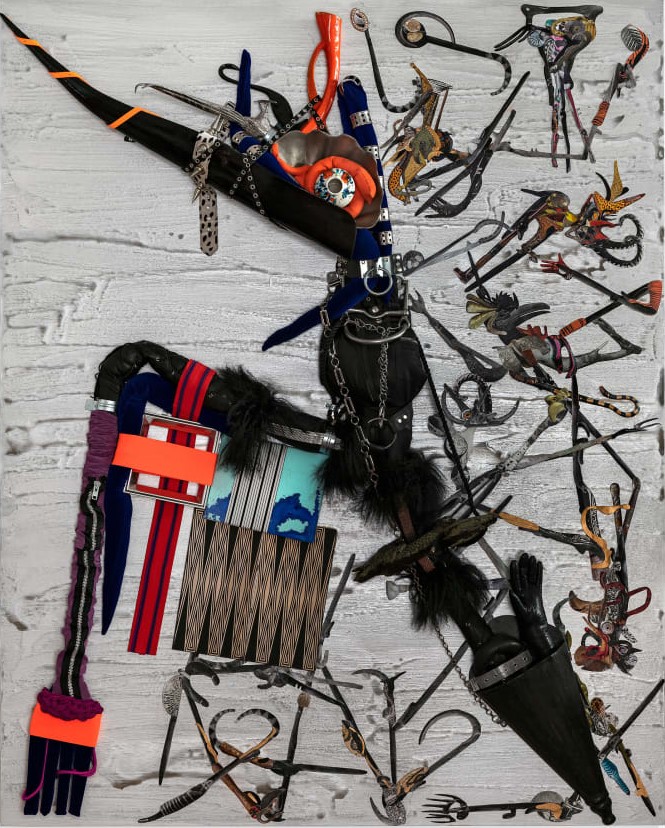Pepe Mar: Myth and Magic
PDF: Matteson, review of Pepe Mar
Curated by: Joanna Robotham
Exhibition schedule: Tampa Museum of Art, July 13, 2023–February 18, 2024
Evoking the featured artist’s critical engagement with assemblage, Pepe Mar: Myth and Magic at the Tampa Museum of Art (TMA) melds formerly disparate elements of Mar’s artistic career into an immersive installation that flourishes as a queer fantasy. The fifteen-year survey is Mar’s most comprehensive retrospective to date, featuring sixty works that demonstrate the breadth of his multimedia practice spanning collage, sculpture, ceramics, painting, and installations. The exhibition was curated by Joanna Robotham, TMA’s curator of modern and contemporary art, and was planned after the museum’s 2019 purchase of Mar’s Burning Up, a sculpture that is included among the other exhibited objects lent by private and public collections.
Mar (b. Mexico, 1977) is an internationally recognized artist who lives and works in Miami. He is currently represented by David Castillo in Miami, and he has had recent solo exhibitions at the Kemper Museum of Contemporary Art in Kansas City (2022) and the Frost Art Museum at Florida International University in Miami (2020). Early in his career, Mar received praise for his vibrant assemblages in which he combines print media, decorative textiles, and found objects purchased at thrift stores into abstracted, patchwork figures that, as the critic Ken Johnson wrote in a 2006 New York Times review, “could be both killing machines from an animated sci-fi movie or overwrought rock’n’roll stars.”1 Mar’s densely layered assemblages demonstrate the depth of his rich visual vocabulary with referents to modern art history, his Mexican heritage, and queer subcultures.
Pepe Mar: Myth and Magic is presented across two spaces. It begins in a smaller corridor that leads into a larger gallery, which is among the seven new exhibition spaces that TMA opened earlier this year as part of their centennial renovation project. Painted in a canary yellow, the corridor is the exhibition’s preamble, featuring the curator’s introductory text and three artworks that speak to Mar’s primary processes and repeated motifs. In her introduction, Robotham outlines the exhibition’s “loosely chronological” organization into four sections: “Assemblage,” “Revival and Mythologies,” “Face-Off,” and “Fabric Paintings.” Potpourri (2018), one of Mar’s four fabric paintings included in the exhibition, hangs to the left of Robotham’s introduction. The work is indicative of Mar’s process of collaging images of his earlier assemblages to create new, disjointed abstractions comprising kaleidoscopic patterns in energetic hues reminiscent of Mexican textiles, American quilts, and Miriam Schapiro’s “femmages.”
Humid Balconies (fig. 1), an installation Mar premiered for his 2019 solo exhibition at Pittsburgh’s Mattress Factory, hangs in the corridor across from Potpourri. Evoking a Wunderkammer (cabinet of curiosity), the mixed-media work combines disparate two- and three-dimensional elements in a densely layered composition. Bursts of dried grasses and artificial greenery project from the turquoise wooden support. Ancient vessels, ceramic figurines, and kitsch tchotchkes all teeter precariously on an orange lattice. Print media and ephemera is interspersed throughout, including a small reproduction of Marcel Duchamp’s Fountain printed on pale pink paper, a photobooth film strip with the artist attempting to conceal his face in each frame, and a flyer for the gay club Enigma. The only repeated image is of a ghoulish, anthropomorphic bat, a nod to the Mayan god Camazotz.

The haphazard juxtaposition of cultural referents disavows logical museum taxonomies, yet the process and history of collecting and display is foundational to Mar’s practice. Building on the precedents of artists like Fred Wilson, Mar has been similarly inspired to develop poetic juxtapositions that reference institutional and private collections—Humid Balconies was inspired by the eclectic collection of the Mattress Factory’s founder Barbara Luderowski. Yet whereas Wilson valued legibility within his reinstallations of museum collections, Mar’s Humid Balconies is impenetrable and seemingly nonsensical. The installation’s randomness makes it both a visual delight and a potentially exhausting game of “I Spy.” The work is expertly curated as part of the exhibition’s introduction, since it acquaints visitors with Mar’s repeated motifs and core processes while also alerting them to the prolonged viewing time his work requires.
The corridor serves as a physical and conceptual threshold, alerting visitors to a transition from TMA’s more conservatively curated exhibition spaces into Mar’s disarming fantasy—a liminal and immersive effect reminiscent of watching Jeannie enter her bottle in the 1960s television sitcom I Dream of Jeannie. As if sliding down the neck of the bottle to access Jeannie’s posh domicile, visitors pass through the narrow, low-ceilinged corridor into a more expansive space with ten of Mar’s assemblages cased in colorful Plexiglas boxes lined up along the facing wall and eight sculptures on pedestals filling the gallery’s center (fig. 2). Like Jeannie’s lair, the space feels contained, with floating walls positioned across from the exhibition’s primary exits acting as visual barriers to the other galleries. While Jeannie favored purple to brighten her bottle, Mar’s exhibition is outfitted with a plush orange carpet whose color radiates off the gallery’s white walls and affords a warmth to the interior space, which is unlike many of TMA’s other galleries, as it lacks a source of natural light. Just as Jeannie takes respite on her round couch, visitors are invited to sit on any of the large poufs that are interspersed among Mar’s floor sculptures, which are made with fabric printed with images of his collages.

Inside the main gallery, visitors encounter various depictions of Paprika, Mar’s name for the figure that recurs throughout his work. An extended label explains that the birdlike Paprika is Mar’s alter ego, one that is neither male nor female, human nor animal. As such, Paprika is distinctly queer for its existence outside of normative binaries. Paprika’s liminality echoes what the exhibition text describes as Mar’s own existence “between two cultures,” having grown up on both sides of the US-Mexico border. Mar also expresses his cultural hybridity through the citation of a global coterie of artists—for example, Paprika’s many faces are in dialogue with Leonora Carrington’s mythological hybrids and Frida Kahlo’s self-portraits. Mar’s cosmopolitanism builds on the legacy of influential Mexican modernist Rufino Tamayo, who blended international avant-garde styles with distinctly Mexican motifs. This link is made explicit by the exhibition’s title, which is borrowed from Tamayo’s 1979 retrospective at the Solomon R. Guggenheim Museum. Just as Carrington, Kahlo, and Tamayo each reconvened modernity with spirituality, Mar cultivates within his work a provocative queer mythology that critiques the very art institutions within which he must also participate.
Each assemblage features a different mutation of Paprika, composed of materials that reference various cultures, aesthetic traditions, and historic events. In Curiosity (2017), one of the earliest assemblages included in the exhibition, Paprika emerges on top of a busy collage composed of a pattern of interlocking circles. The creature’s headdress radiates outward, combining images of different natural and humanmade materials. In this instance, Paprika’s blue raffia beak droops downward, while its top-heavy body balances on a navy wormlike tail. The title references NASA’s Mars Curiosity Rover, a mission of otherworldly discovery that is perhaps a metaphor for the type of puzzling analysis the viewer performs while contemplating Paprika’s alien body. The Icon (2021) hangs on the floating wall at the gallery’s center, anchoring the “Assemblage” section of the exhibition. In this work, Paprika’s face is presented in profile, composed of different ceramic elements and cylindrical soft sculptures. A rainbow ribbon encircles Paprika’s mouth, gesturing to the LGBTQ+ pride flag. Though both Curiosity and The Icon present Paprika in a different form, they similarly pique the viewer’s curiosity into tracing the mythology and evolution of Mar’s alter ego, beckoning us to carefully examine each assemblage.
Penca Leatherboy (figs. 3 and 4) is the largest assemblage included in this exhibition, and it is displayed at the center of the gallery’s south wall. The work includes nods to BDSM and leather subcultures: Paprika wears black; a chain is draped around their body; a gloved leather hand juts out from a conical leg; and they are ominously surrounded on the right by what appear to be tools of torture. The work’s neon container adds to the assemblage’s dangerous allure, setting it apart from the other, more whimsical presentations of Paprika. Penca Leatherboy’s extended label notes that the leather materials were purchased from Out of the Closet—a South Florida thrift store that caters to the LGBTQ+ community and raises funds for the AIDS Healthcare Foundation. Unlike Robert Rauschenberg, who resisted coded interpretations of his early assemblages by claiming they followed a “random order,” Mar is unapologetically and proudly intentional about how his material choices are imbued with queer memory and signification.2
Paprika is also the subject of the twenty portraits (2016–22) that comprise “Face-Off,” the least developed section of the exhibition. These two-dimensional collages depict expressive transfigurations of Paprika’s face made with various images abstractly cut and arranged. Displayed in a small salon-style grouping, the works feel like a space filler rather than a conscientious addition to the exhibition’s narrative. The collages lack the seductive tactility of Mar’s assemblages and floor sculptures—their lackluster visual impact may explain Robotham’s decision to include the least amount of didactic material within this section of the exhibition. If presented independently, the collages certainly would prove to be an intriguing subject of study. Yet within the scope of this retrospective, they are overpowered by Mar’s more substantive, sensational works.
Throughout the exhibition there are many visual cues to music. In the assemblage Jukebox (2021), Paprika perches on two CDs, a Paulina Rubio album and the soundtrack for the Showtime series Queer as Folk. An album list featuring club mixes of popular gay anthems peeks out from a grouping of ephemera in Revival II (2012), one of the assemblages in the “Revival and Mythologies” section of the exhibition. Tickets for a Cher concert, a flyer advertising an album-release party at South Beach’s TWIST nightclub, and a wristband for a tea dance are haphazardly clipped into one of Mar’s scrapbooks on display in a nearby case. Given these various references to music and the rhythmic quality of Mar’s vibrant work, the gallery’s silence was unnervingly palpable. Though I initially questioned this decision to omit a thoughtfully curated soundscape, I have since realized that Pepe Mar: Myth and Magic has a similar effect to the moment of pause after the music stops and the dancing ends: the lights turn on, and you look down at the littered, glimmering debris with that lingering, euphoric sense of ecstasy afforded only by having reveled in beauty.
Cite this article: David Matteson, review of Pepe Mar: Myth and Magic, Tampa Museum of Art, Panorama: Journal of the Association of Historians of American Art 9, no. 2 (Fall 2023), https://doi.org/10.24926/24716839.18372.
Notes
- Ken Johnson, “Pepe Mar: Hunga Bunga,” New York Times, August 11, 2006, https://www.nytimes.com/2006/08/11/arts/art-in-review-pepe-mar-hunga-bunga.html. ↵
- For more on the debate over the queer signification of Rauschenberg’s assemblages, see Jonathan D. Katz, “‘Committing the Perfect Crime’: Sexuality, Assemblage, and the Postmodern Turn in American Art,” Art Journal 67, no. 1 (March 2008): 38–53. ↵
About the Author(s): David Matteson is a PhD candidate at the University of Central Florida and Associate Curator of Education at the Rollins Museum of Art.



